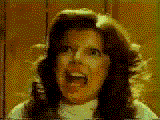As the sub-genre of the monstrous-child films gathered momentum, an increasing number of films were given titles which referred directly to the womb--or its progeny--as the originating point of horror. These include Polanski's classic, Rosemary's Baby (1968), in which a woman gives birth to the Devil's offspring; Demon Seed (1977); Bloody Birthday (1980); and Devil Foetus (1983).
The majority of horror films, which draw a connection between the monstrous child and its mother, deal with female offspring. In those films in which the monstrous infant is male (Rosemary's Babv, It's Alive, It Lives Again), little emphasis is placed on the mother-son relationship. The monstrous little girl threatens, however, because she has inherited the propensity for evil while in the womb. These films are not concerned with the "heredity versus environment" debate. Rather, they argue that, due to some form of deadly contamination in the womb, or genetic predisposition, the infant--particularly the female--is likely to be born bad. It is the mother's seed--not the father's--which implants evil in these children.
In films discussed previously--from The Bad Seed and Curse of the Cat People to Carrie and The Brood--we see a similar pattern, an uncanny relationship between mother and daughter. Freud (1919) defined the uncanny as those things that arouse a sense of "dread and horror" in the subject. One of the three groupings he specified as uncanny, relates to the womb. The uncanny, or the unheimlich, is "that class of the frightening which leads back to what is known of old and long familiar." (220) A central place in the history of all subjects, which is "old and long familiar" is the womb--the unheimlich, that which once was heimisch. Freud also defined the uncanny in terms of that class of things that relates to the double such as twins, a doppelganger, a ghost, or repetition of an act. Film about the monstrous-little woman bring together the womb and the double as a twin source of horror.

|
|
The Doubled Mother
1.5MB quicktime movie |
Those of us who love horror films, recognise there is also great pleasure in watching the monstrous little woman strut her stuff. The history of woman as witch, the association between possession and hysteria, the cultural/religious fantasy of woman as sexually insatiable, and the popular myth of the girl as innocent and impressionable, helps explain the greater number of girl's--rather than boys--who star in horror films about possession. These factors may also explain the larger number of monstrous little women, overall, in the cinema. The horror film permits a violation of boundaries, a return of the repressed, a carnivalesque breaking of taboos--these activities are its raison d'etre. Although representations of monstrous little women no doubt stems from phallocentric bias, our daughters of darkness ironically have come to represent a fantasy, a potent symbol, of the way in which we, as adults, wish to remember what might have been. So much more the pleasure, then, for the female viewer when the mad moppet is the one to lead the attack--to spew, curse and kill--to draw attention to the fragility of the symbolic order.